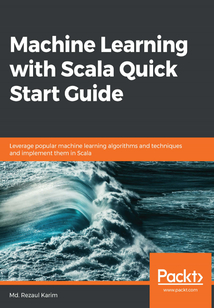舉報 

會員
Machine Learning with Scala Quick Start Guide
Scalaisahighlyscalableintegrationofobject-orientednatureandfunctionalprogrammingconceptsthatmakeiteasytobuildscalableandcomplexbigdataapplications.ThisbookisahandyguideformachinelearningdevelopersanddatascientistswhowanttodevelopandtraineffectivemachinelearningmodelsinScala.Thebookstartswithanintroductiontomachinelearning,whilecoveringdeeplearningandmachinelearningbasics.ItthenexplainshowtouseScala-basedMLlibrariestosolveclassificationandregressionproblemsusinglinearregression,generalizedlinearregression,logisticregression,supportvectormachine,andNa?veBayesalgorithms.Italsocoverstree-basedensembletechniquesforsolvingbothclassificationandregressionproblems.Movingahead,itcoversunsupervisedlearningtechniques,suchasdimensionalityreduction,clustering,andrecommendersystems.Finally,itprovidesabriefoverviewofdeeplearningusingareal-lifeexampleinScala.
目錄(151章)
倒序
- coverpage
- Title Page
- Copyright and Credits
- Machine Learning with Scala Quick Start Guide
- About Packt
- Why subscribe?
- Packt.com
- Contributors
- About the author
- About the reviewers
- Packt is searching for authors like you
- Preface
- Who this book is for
- What this book covers
- To get the most out of this book
- Download the example code files
- Code in Action
- Conventions used
- Get in touch
- Reviews
- Introduction to Machine Learning with Scala
- Technical requirements
- Overview of ML
- Working principles of a learning algorithm
- General machine learning rule of thumb
- General issues in machine learning models
- ML tasks
- Supervised learning
- Unsupervised learning
- Reinforcement learning
- Summarizing learning types with applications
- Overview of Scala
- ML libraries in Scala
- Spark MLlib and ML
- ScalNet and DynaML
- ScalaNLP Vegas and Breeze
- Getting started learning
- Description of the dataset
- Configuring the programming environment
- Getting started with Apache Spark
- Reading the training dataset
- Preprocessing and feature engineering
- Preparing training data and training a classifier
- Evaluating the model
- Summary
- Scala for Regression Analysis
- Technical requirements
- An overview of regression analysis
- Learning
- Inferencing
- Regression analysis algorithms
- Performance metrics
- Learning regression analysis through examples
- Description of the dataset
- Exploratory analysis of the dataset
- Feature engineering and data preparation
- Linear regression
- Generalized linear regression (GLR)
- Hyperparameter tuning and cross-validation
- Hyperparameter tuning
- Cross-validation
- Tuning and cross-validation in Spark ML
- Summary
- Scala for Learning Classification
- Technical requirements
- Overview of classification
- Developing predictive models for churn
- Description of the dataset
- Exploratory analysis and feature engineering
- LR for churn prediction
- NB for churn prediction
- SVM for churn prediction
- Summary
- Scala for Tree-Based Ensemble Techniques
- Technical requirements
- Decision trees and tree ensembles
- Decision trees for supervised learning
- Decision trees for classification
- Decision trees for regression
- Gradient boosted trees for supervised learning
- Gradient boosted trees for classification
- GBTs for regression
- Random forest for supervised learning
- Random forest for classification
- Random forest for regression
- What's next?
- Summary
- Scala for Dimensionality Reduction and Clustering
- Technical requirements
- Overview of unsupervised learning
- Clustering analysis
- Clustering analysis algorithms
- K-means for clustering analysis
- Bisecting k-means
- Gaussian mixture model
- Other clustering analysis algorithms
- Clustering analysis through examples
- Description of the dataset
- Preparing the programming environment
- Clustering geographic ethnicity
- Training the k-means algorithm
- Dimensionality reduction
- Principal component analysis with Spark ML
- Determining the optimal number of clusters
- The elbow method
- The silhouette analysis
- Summary
- Scala for Recommender System
- Technical requirements
- Overview of recommendation systems
- Types of recommender systems
- Similarity-based recommender systems
- Content-based filtering approaches
- Collaborative filtering approaches
- The utility matrix
- Model-based book recommendation system
- Matrix factorization
- Exploratory analysis
- Prepare training and test rating data
- Adding new user ratings and making new predictions
- Summary
- Introduction to Deep Learning with Scala
- Technical requirements
- DL versus ML
- DL and ANNs
- ANNs and the human brain
- A brief history of neural networks
- How does an ANN learn?
- Training a neural network
- Weight and bias initialization
- Activation functions
- Neural network architectures
- DNNs
- Autoencoders
- CNNs
- RNNs
- Generative adversarial networks (GANs)
- Capsule networks
- DL frameworks
- Getting started with learning
- Description of the dataset
- Preparing the programming environment
- Preprocessing
- Dataset preparation
- LSTM network construction
- Network training
- Evaluating the model
- Observing the training using Deeplearning4j UI
- Summary
- Other Books You May Enjoy
- Leave a review - let other readers know what you think 更新時間:2021-06-24 14:32:26
推薦閱讀
- Introduction to DevOps with Kubernetes
- 空間機器人遙操作系統及控制
- 輕松學Java
- 計算機網絡應用基礎
- CorelDRAW X4中文版平面設計50例
- 氣動系統裝調與PLC控制
- 激光選區熔化3D打印技術
- 空間機械臂建模、規劃與控制
- 單片機技能與實訓
- C++程序設計基礎(上)
- Learning Apache Apex
- Photoshop CS4數碼攝影處理50例
- 未來學徒:讀懂人工智能飛馳時代
- 生成對抗網絡項目實戰
- 機器學習案例分析(基于Python語言)
- Effective Business Intelligence with QuickSight
- 軟測之魂
- 智能小車機器人制作大全(第2版)
- 創客機器人實戰:基于Arduino和樹莓派
- 百度智能小程序:AI賦能新機遇
- 數據結構與算法(C++語言版)
- 智能機器人創新熱點與趨勢
- 數據庫技術:Access 2003 計算機網絡技術
- S7-200系列PLC應用技術
- 軟件設計
- 仿魚機器人的設計與制作
- 微機原理與應用
- 微機原理與接口技術(基于32位機)
- Machine Learning Quick Reference
- 初入職場之嵌入式Linux開發快速上手

